Vivo V9 Review: An iPhone X wannabe w ith one of the best selfie cameras around
Chinese smartphone maker Vivo launched
the Vivo V9 in the market for a price of Rs 22,999. This new device
comes less than four months after the company launched its previous
offering, the Vivo V7.
The V9 brings an updated design with more powerful internals to make it
a serious contender in the mid-range smartphone segment.
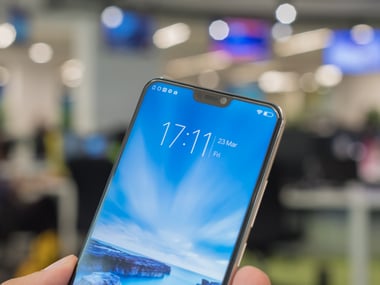
Build and Design: 7.5/10
The first thing that you notice when you first switch on the Vivo V9, or see someone using it, is that lovely display and it's almost ‘edge-to-edge' design. Yes, the design — both hardware and software — is a complete and total rip-off of the iPhone and iOS, but once you get past that, you realise that the phone still makes quite an impression in this segment right now. However, once the market is flooded with notches, I really doubt this phone's ability to stand out.
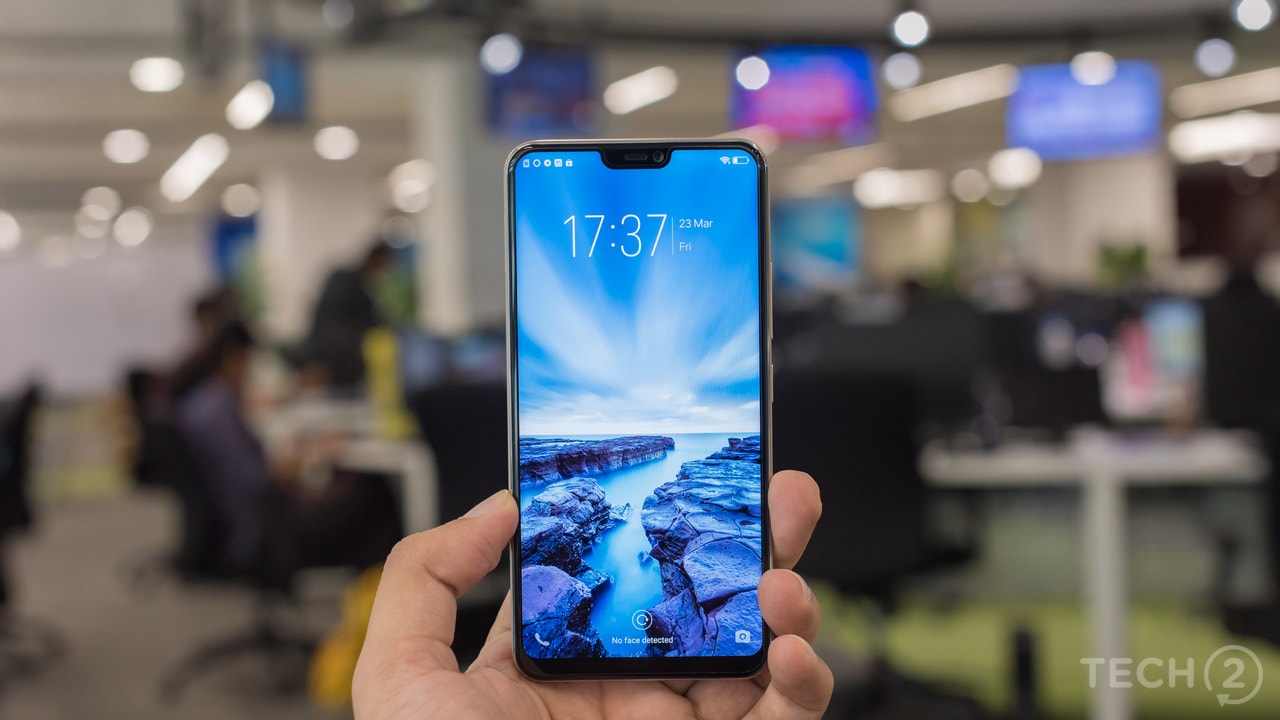 With the exception of the camera design, you're not going to be able
to tell the V9 apart from any other Vivo device. The company has added a
dual camera setup in an iPhone X-like vertical setup towards the top
left corner of the smartphone, along with an LED flash unit.
With the exception of the camera design, you're not going to be able
to tell the V9 apart from any other Vivo device. The company has added a
dual camera setup in an iPhone X-like vertical setup towards the top
left corner of the smartphone, along with an LED flash unit.
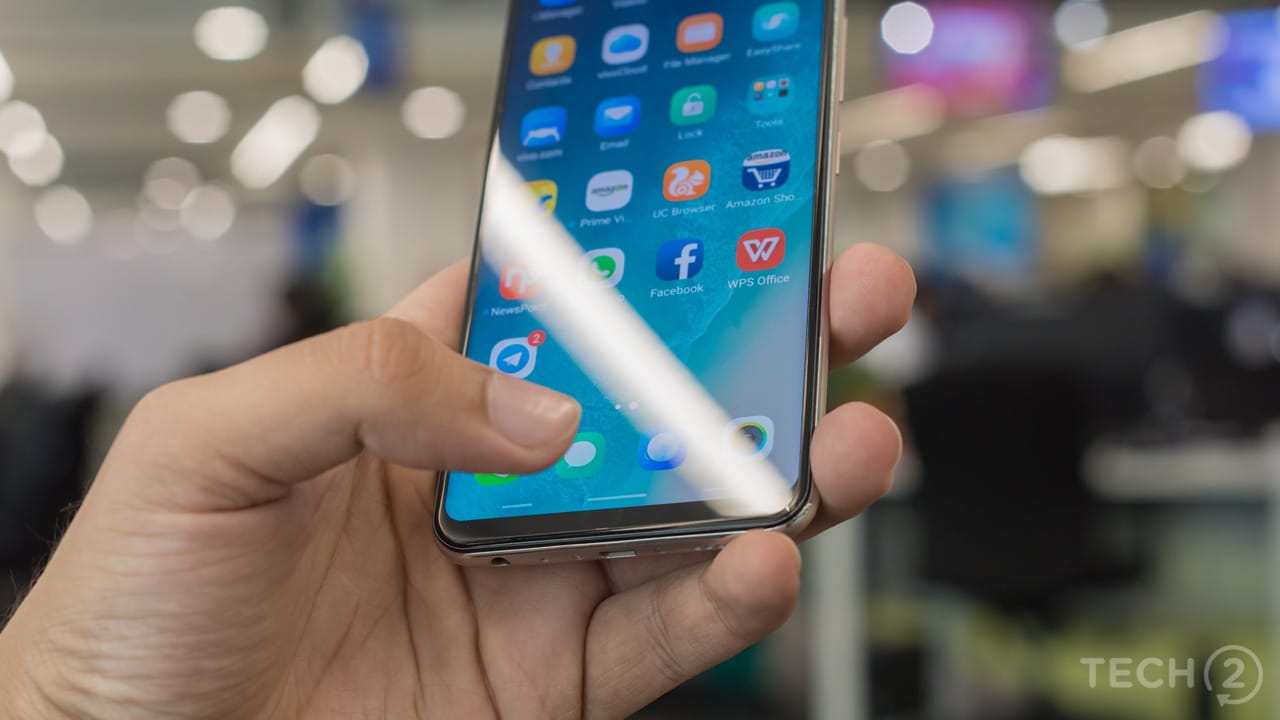
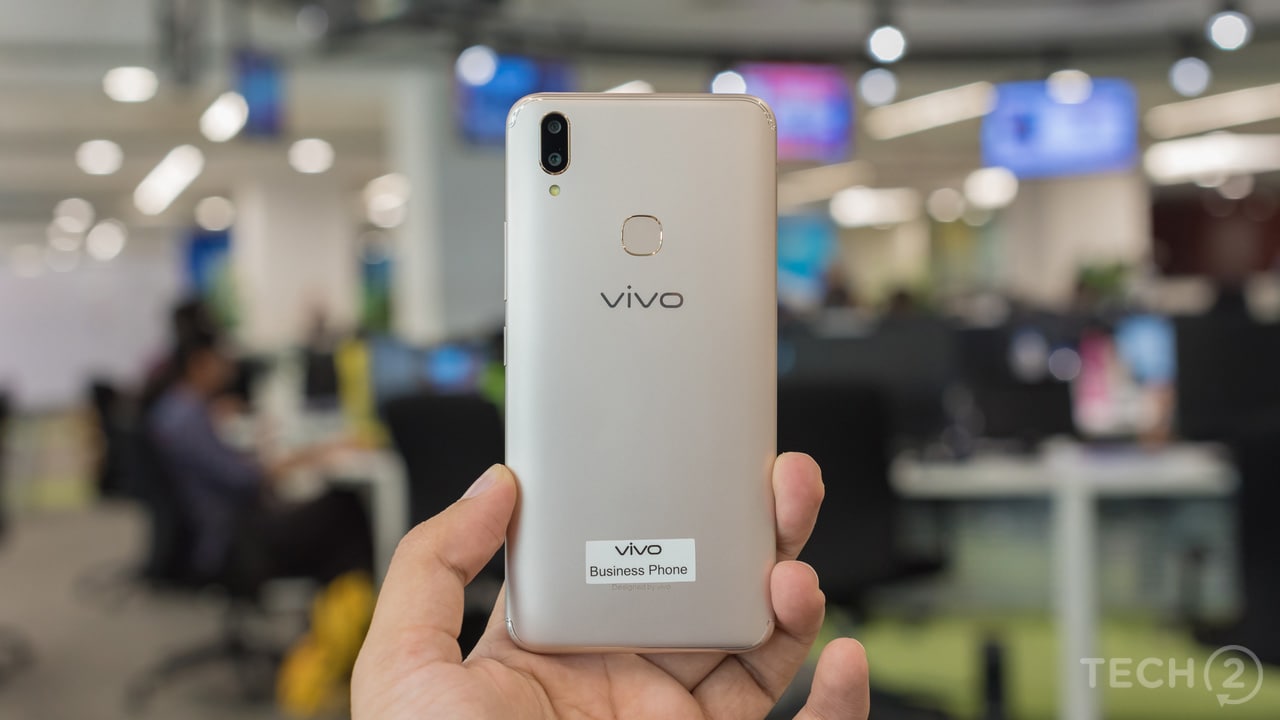 The front of the device is mostly the display with a small chin at
the bottom and the notch on the top. The notch houses the front speaker
and 24 MP front camera sensor.
The front of the device is mostly the display with a small chin at
the bottom and the notch on the top. The notch houses the front speaker
and 24 MP front camera sensor.
There are no hardware navigation buttons to reduce the size of the bottom chin and Vivo has opted for software navigation buttons instead. Vivo has also added an iPhone X-like gesture-based navigation system that reduces the navigation buttons to mere indicators, increasing the effective screen estate for the content.
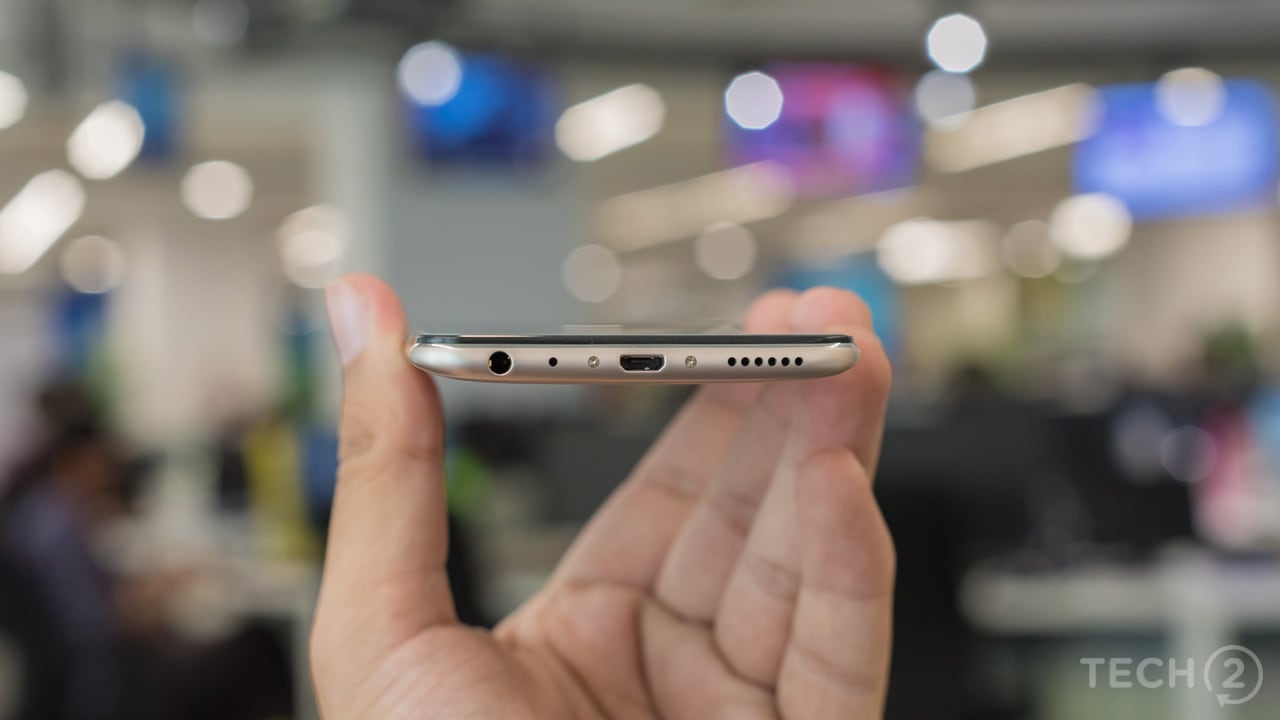 The V9 comes with high-quality plastic on the back that curves on the
sides of the smartphone to give the user a comfortable grip. Plastic
caps are at the top and bottom. The fingerprint scanner is on the rear.
The V9 comes with high-quality plastic on the back that curves on the
sides of the smartphone to give the user a comfortable grip. Plastic
caps are at the top and bottom. The fingerprint scanner is on the rear.
 The dual SIM slot tray along with a dedicated microSD card slot is
located towards the top on the left side of the device. You will find
the power button and the volume rocker on the right side of V9. Moving
towards the bottom of the device, you will find the microUSB port in the
middle, with a 3.5 mm headphone jack and a speaker grill on either
side.
The dual SIM slot tray along with a dedicated microSD card slot is
located towards the top on the left side of the device. You will find
the power button and the volume rocker on the right side of V9. Moving
towards the bottom of the device, you will find the microUSB port in the
middle, with a 3.5 mm headphone jack and a speaker grill on either
side.
Features: 7/10
Vivo V9 packs in a 6.3-inch screen with FHD+ resolution and a 90 percent screen-to-body ratio with an iPhone X-like notch on the top, something I'll talk more about in the display section.
The V9 packs in a Snapdragon 626 SoC with 4 GB RAM and 64 GB internal storage. Vivo will also give users an option to add a microSD card with up to 256 GB capacity for expandable storage with the help of a ‘triple card slot’. It comes with a 16 MP rear camera sensor with an f/2.0 aperture and a 5 MP camera sensor for sensing the depth. A 24 MP camera sensor is on the front of the device.
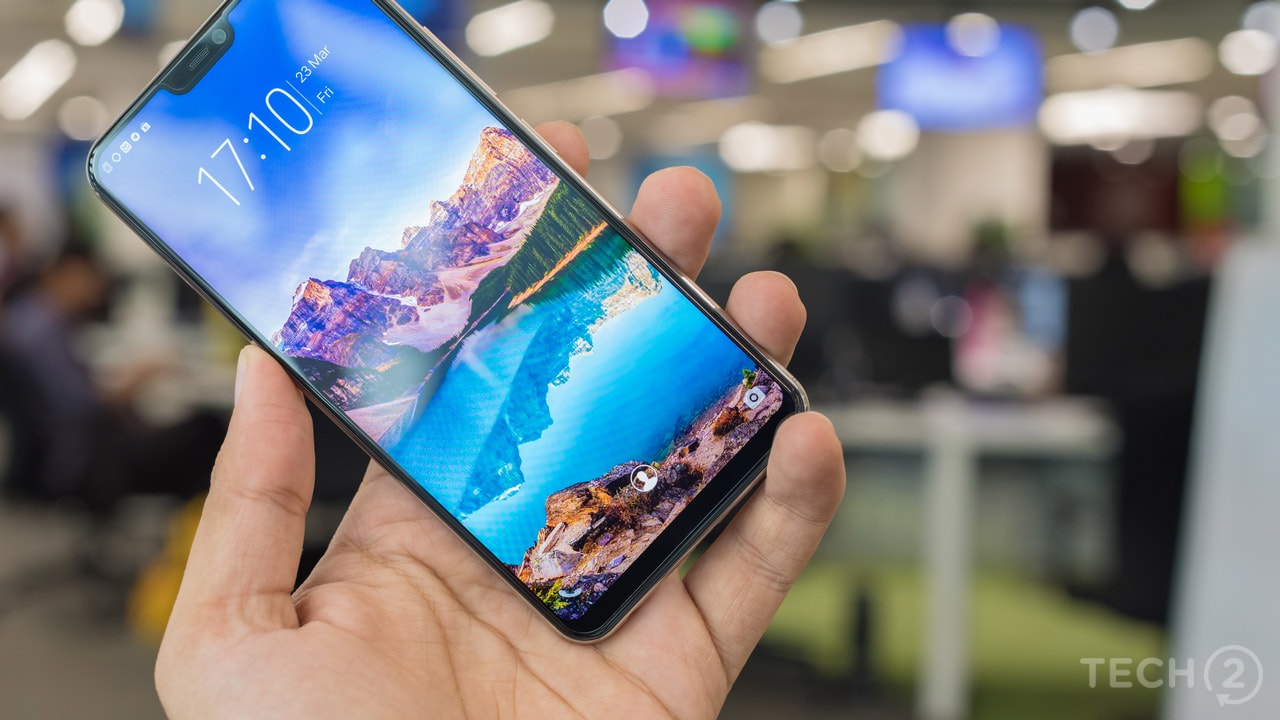 The device also comes with a microUSB port, OTG, GPS, dual-band
Wi-Fi, Bluetooth v4.2 and headphone jack. It is disappointing to see a
microUSB port in a device launched in 2018, especially with that
notch-happy screen, but you will have to deal with it.
The device also comes with a microUSB port, OTG, GPS, dual-band
Wi-Fi, Bluetooth v4.2 and headphone jack. It is disappointing to see a
microUSB port in a device launched in 2018, especially with that
notch-happy screen, but you will have to deal with it.
Display: 7/10
The Vivo V9 will pack in a 6.3-inch IPS LCD screen with a 19:9 aspect ratio and an FHD+ resolution of 2280 x 1080 pixels. With that notch, you get a 90 percent screen-to-body ratio. Love it or hate it, that Android smartphone makers are adopting the notch. The display looks quite nice in real life.
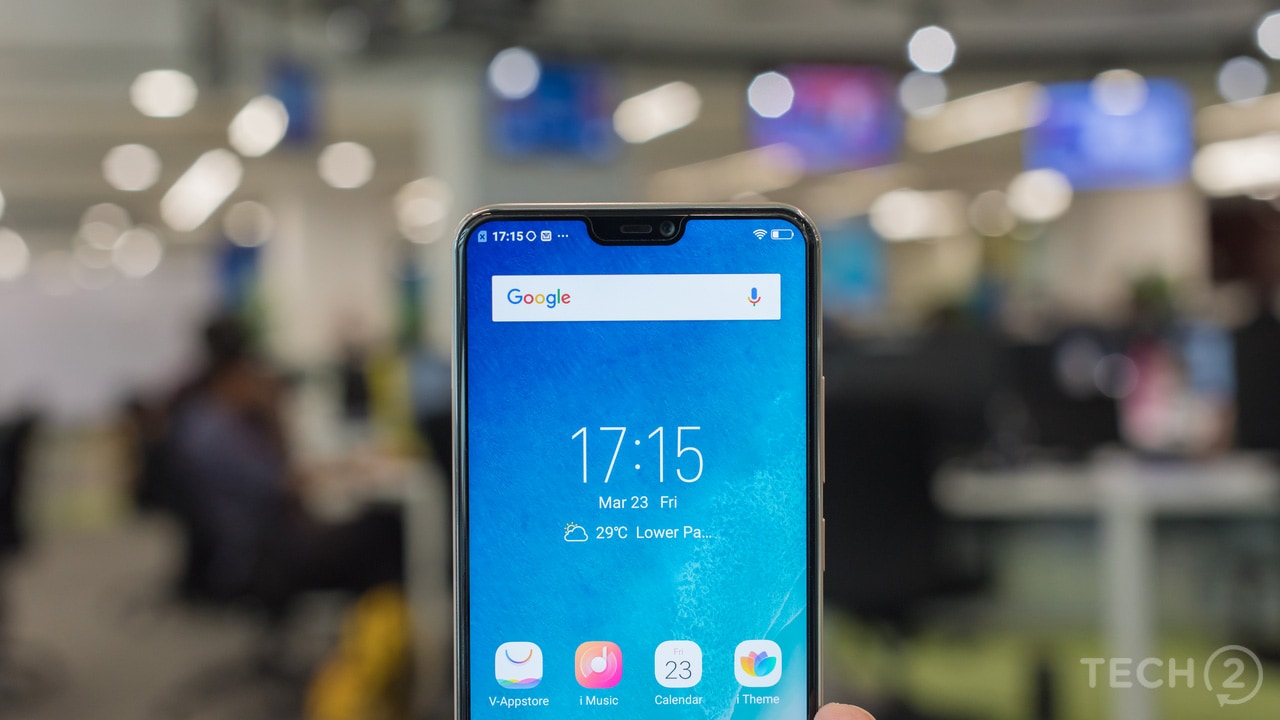 You do get habituated to the notch and it won't really matter much in
the long run. The only issue is that apps still aren't optimised to
deal with the notch. Hopefully, this will be remedied soon.
You do get habituated to the notch and it won't really matter much in
the long run. The only issue is that apps still aren't optimised to
deal with the notch. Hopefully, this will be remedied soon.
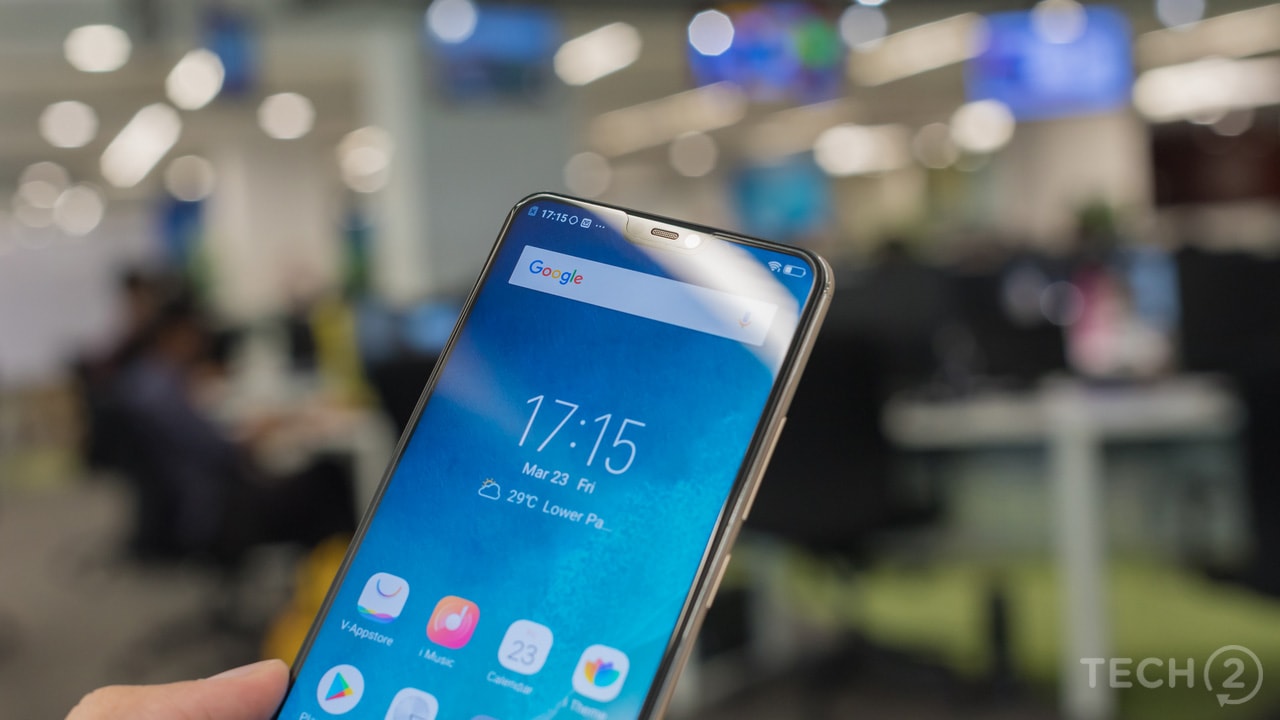 Most apps don't use the edge to edge interface and come with a status
bar area on the top. However, I found that the notch was coming in the
way while viewing Instagram stories or Snapchat stories, making it
somewhat irritating. The display has good viewing angles when it comes
colour reproduction on the screen. However, the display brightness takes
a hit if viewed from an angle, reducing the overall impact of the
edge-to-edge design. Apart from display brightness and viewing angle, I
feel that the company should have included a different panel with more
brightness as the included panel was lacking in that department.
Most apps don't use the edge to edge interface and come with a status
bar area on the top. However, I found that the notch was coming in the
way while viewing Instagram stories or Snapchat stories, making it
somewhat irritating. The display has good viewing angles when it comes
colour reproduction on the screen. However, the display brightness takes
a hit if viewed from an angle, reducing the overall impact of the
edge-to-edge design. Apart from display brightness and viewing angle, I
feel that the company should have included a different panel with more
brightness as the included panel was lacking in that department.
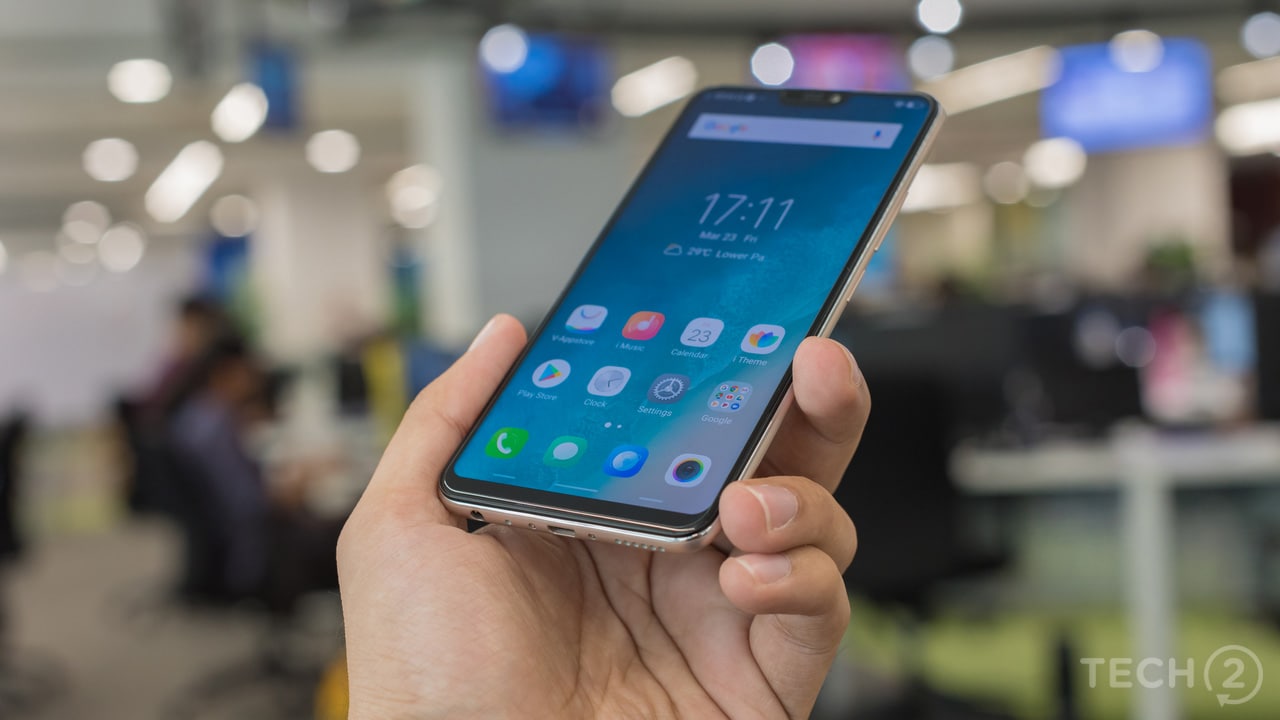 The screen worked as intended in bright environments, though you
still would end up searching for shade because of the highly reflective
display when you are in direct sunlight.
The screen worked as intended in bright environments, though you
still would end up searching for shade because of the highly reflective
display when you are in direct sunlight.
Software: 6.5/10
The V9 sports Vivo's Android 8.1 Oreo-based Funtouch OS 4.0 out of the box along with the March Android security patch. As noted in my first impressions, Vivo tries to take the 'imitation is the best form of flattery' approach when it comes to iOS by making Funtouch OS 4.0 as visually close to iOS as possible. Everything, the icons, the notification tray, settings menu, calendar apps and more are heavily inspired by iOS. The company almost copies the swipe-up-from-the-bottom gesture to invoke the quick action bar with controls such as the Wi-Fi, Bluetooth, Data network, Rotation lock, brightness and volume controls.
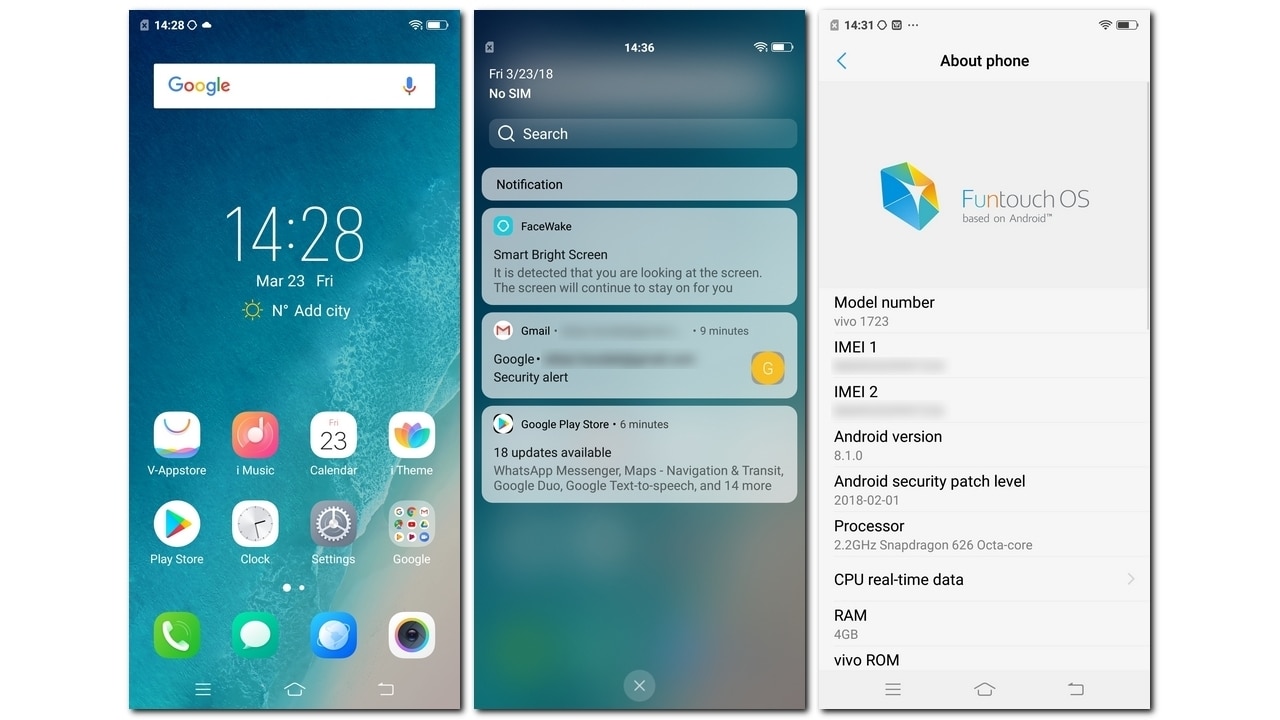
The company claims a lot of Artificial Intelligence (AI)-powered smarts in the system, most of which are difficult to realise in the day-to-day functioning of the device. However, the company claims to pack 'AI Bokeh' along with the dual camera setup to make use of the algorithm and machine learning to “achieve amazing bokeh shots” along with “AI Face Access” for face unlock. Another feature called “AI Attention Sensing” improves the user experience, according to Vivo, by monitoring when you're looking at the phone. In this case, message notifications, alarms and other notifications will be more muted.
Face unlock works fine in most situations, but there were some situations where the phone could not recognise my face and I had to use my password to unlock the V9.
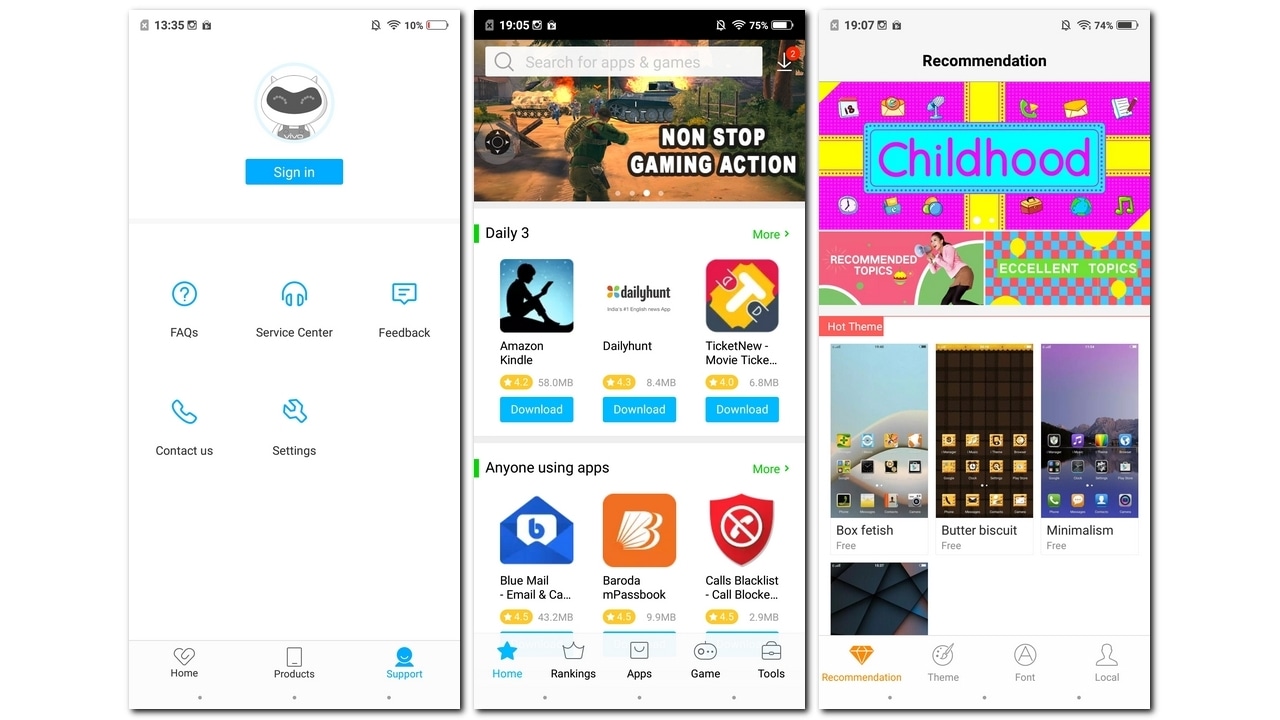 It also comes with an updated 'Game Mode' so that you can play games
without any notifications disrupting your experience. You can set a
select number of contacts whose calls can notify you while you are in
Game Mode. 'Picture in Picture' is supported for a select number of
apps. The 'Game Mode' also comes with a new 'Gaming Keyboard', which
reduces the size of your keyboard.
It also comes with an updated 'Game Mode' so that you can play games
without any notifications disrupting your experience. You can set a
select number of contacts whose calls can notify you while you are in
Game Mode. 'Picture in Picture' is supported for a select number of
apps. The 'Game Mode' also comes with a new 'Gaming Keyboard', which
reduces the size of your keyboard.
 The software comes along with options such as 'Smart motion' to
unlock the screen along with 'Air operation' where you can wave over the
proximity sensor to unlock the phone or to check the status of
notifications on the lock screen. You also get the option to
raise-to-wake your phone (an iOS feature) with an option to double tap
on the screen of the device to turn off the screen. Vivo has also added a
number of features in its 'Smart call' option in the 'Smart motion'
menu in the settings app where you can call a contact directly by
putting your phone close to your ear if you have opened the contact
details, message thread or call details for that particular contact.
This applies to answering the call by holding the phone near your ear
when a call in incoming.
The software comes along with options such as 'Smart motion' to
unlock the screen along with 'Air operation' where you can wave over the
proximity sensor to unlock the phone or to check the status of
notifications on the lock screen. You also get the option to
raise-to-wake your phone (an iOS feature) with an option to double tap
on the screen of the device to turn off the screen. Vivo has also added a
number of features in its 'Smart call' option in the 'Smart motion'
menu in the settings app where you can call a contact directly by
putting your phone close to your ear if you have opened the contact
details, message thread or call details for that particular contact.
This applies to answering the call by holding the phone near your ear
when a call in incoming.
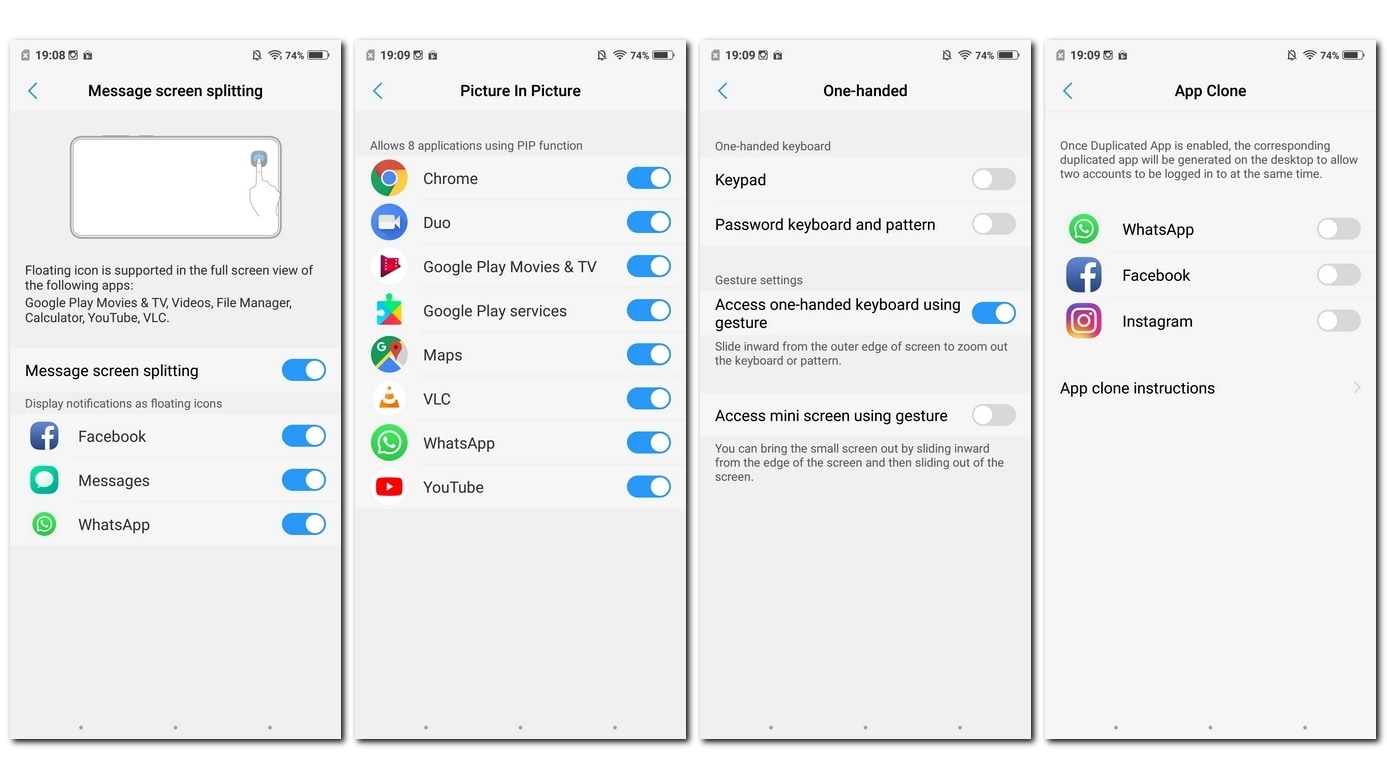
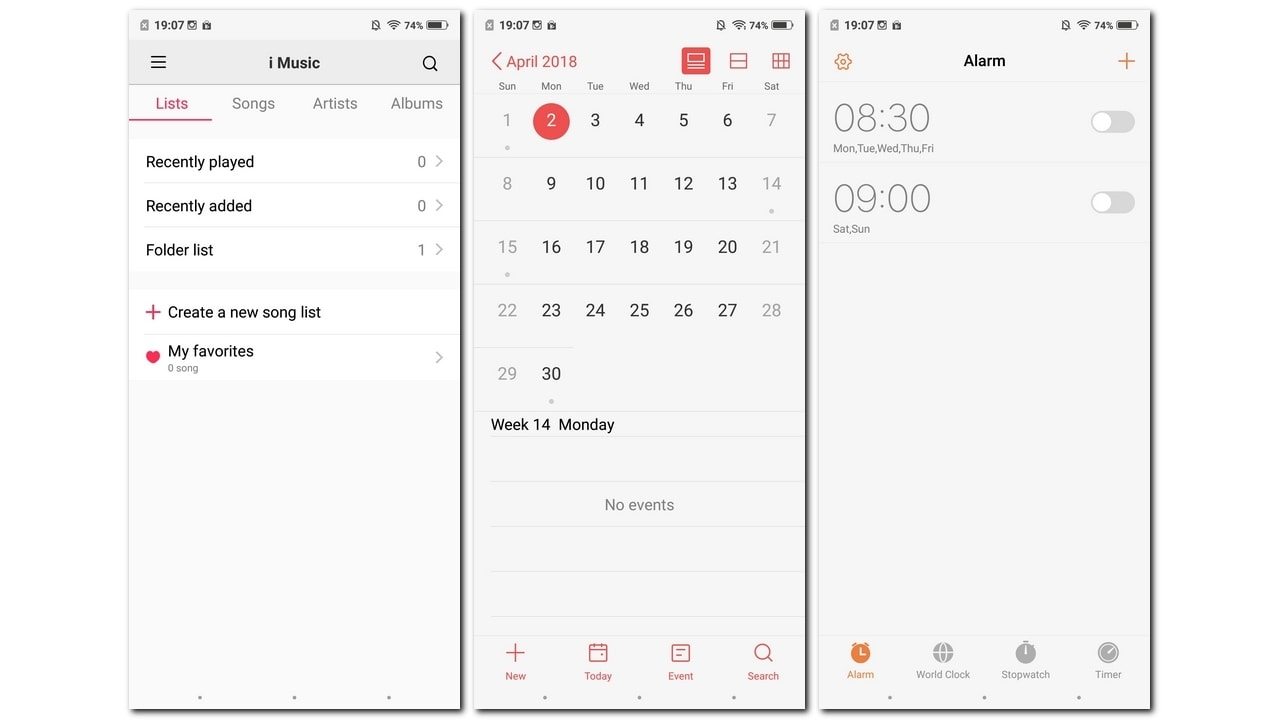 Users can also switch to speaker mode when in hands-free mode by
bringing the phone near to their ear, cover the screen to mute an
incoming call or even wave on top of the phone to answer the phone call
in a hands-free mode. They can also shake the phone to turn on the flash
flight or tilt the device to zoom images. Other features include 'Wi-Fi
Display', 'Smart Split', 'One-handed' mode with 'One-handed keyboard'
and 'access to a mini screen using a gesture'. Options abound.
Users can also switch to speaker mode when in hands-free mode by
bringing the phone near to their ear, cover the screen to mute an
incoming call or even wave on top of the phone to answer the phone call
in a hands-free mode. They can also shake the phone to turn on the flash
flight or tilt the device to zoom images. Other features include 'Wi-Fi
Display', 'Smart Split', 'One-handed' mode with 'One-handed keyboard'
and 'access to a mini screen using a gesture'. Options abound.
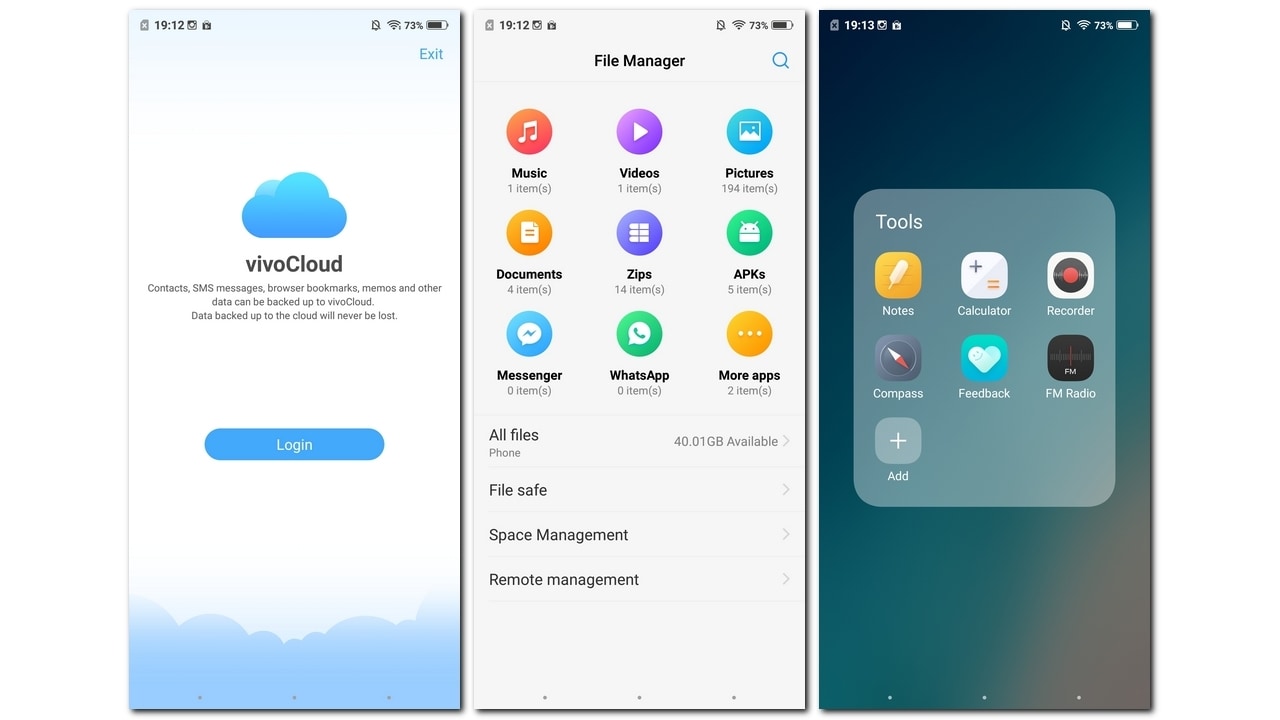
 Considering that this is a skinned OS, built-in apps such as 'i
Music', 'Calendar', 'i Theme', 'Clock', 'Albums', 'Videos', 'Notes',
'Calculator', 'Recorder', 'Contacts', and 'Weather' try to emulate iOS.
The OS comes preloaded with a number of third-party apps including 'UC
Browser', 'Flipkart', 'NewsPoint', 'Instagram', 'Facebook' and 'WPS
Office'. Other bloatware includes 'vivoCloud', 'EasyShare', 'vivo.com',
'Lock', 'Compass', 'Feedback' and 'FM Radio'. There are some apps that
have not been optimised to the 19:9 aspect ratio so the software gives
the option to stretch the app as it deems fit, essentially fixing the
app.
Considering that this is a skinned OS, built-in apps such as 'i
Music', 'Calendar', 'i Theme', 'Clock', 'Albums', 'Videos', 'Notes',
'Calculator', 'Recorder', 'Contacts', and 'Weather' try to emulate iOS.
The OS comes preloaded with a number of third-party apps including 'UC
Browser', 'Flipkart', 'NewsPoint', 'Instagram', 'Facebook' and 'WPS
Office'. Other bloatware includes 'vivoCloud', 'EasyShare', 'vivo.com',
'Lock', 'Compass', 'Feedback' and 'FM Radio'. There are some apps that
have not been optimised to the 19:9 aspect ratio so the software gives
the option to stretch the app as it deems fit, essentially fixing the
app.
Performance: 7.5/10
Moving to the performance of the device, it performs without any major hiccups, slowdowns or crashes. The device did tend to slow down a bit while multitasking and while playing heavy games, but that is alright given that it is powered by Qualcomm Snapdragon 626, which is a high-end chip, but one targeted more towards efficiency. Despite not running a Qualcomm Snapdragon 845 or 835, it ran smoothly through my intensive day-to-day usage without breaking into much sweat.
I did not experience any freezing or stuttering except maybe once or twice while playing Modern Combat 5, and only during intensive 1-hour long gaming sessions. However, considering that it packs a Snapdragon 626, it lags behind its competition when it comes to raw performance and benchmarks. What is surprising is that devices such as the Redmi Note 5 at almost half the cost manage to beat the V9 in some benchmarks.
V9 ran heavy games like Gear.Club, Breakneck, Modern Combat 5 and Dead Trigger 2 without much problem. One thing I need to point out is that the device did not get too hot during intensive gaming sessions, and the little heat that was there was evenly distributed on the rear side instead of being concentrated in one spot. The device was also relatively quick to cool down despite having a plastic back. I did not face any problems while making internet or cellular calls with the device as the connectivity and voice clarity were spot on.
Camera: 7/10
Vivo claims that the highlight feature of the device is its 24 MP camera sensor on the front of the device with its f/2.0 aperture for improved selfies. Vivo made some bold claims about the camera capability of the device during the launch event, adding that the V9 packs in a new ‘AI Face Beauty’ feature along with 'AI HDR' and an 'Ultra HDR' mode. The company added that an algorithm looks at the lighting conditions, age, gender, skin tone and the texture of the user to figure out the optimal settings for a selfie.
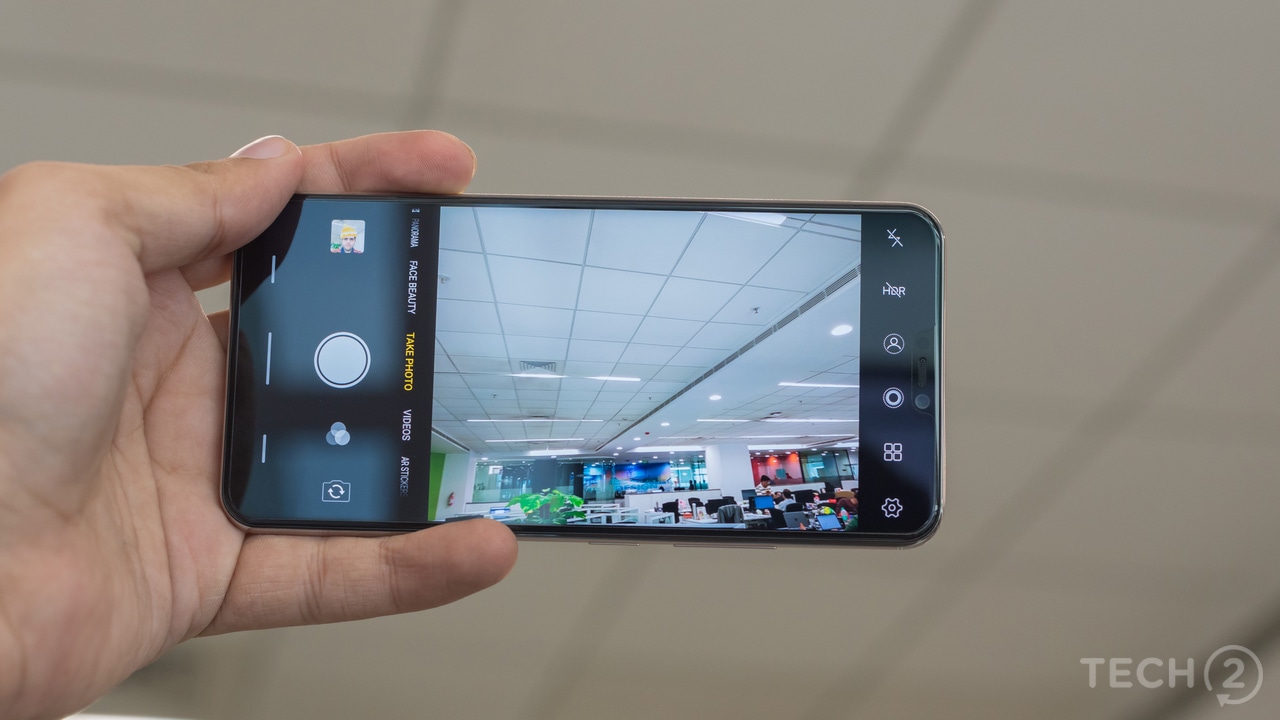

As mentioned earlier, the rear features a 16 MP + 5 MP dual camera, with the 5 MP unit acting as a depth sensor. This is Vivo's first rear-mounted dual-camera. The images shot on the V9 are good in daylight, featuring ample details and decent colour reproduction. I could notice the algorithm sharpening the images a bit more than necessary, but I preferred the final shots as they make it seem like the camera is capturing more details. The low light performance of the phone still needs improvement as the device tends to be extremely aggressive with the noise reduction.

The camera software gives users the option to take an HDR, portrait or Live Photo using the front camera, while switching to the back camera adds various 'mode' options, allowing users to select from ‘Ultra HD’, ‘Doc’ for scanning documents, ‘Slo-Mo’, and ‘Time-Lapse’ modes.
Talking about the shooting modes, the software offers ‘AR Stickers’, ‘Videos’, ‘Take Photo’, ‘Face Beauty’, ‘Panorama’, and ‘Professional’ modes. The ‘Panorama’ mode changes to ‘Group Selfie’ while switching to the front camera’. Though I am not a fan of the 'Face Beauty' mode for the over processing that it does while trying to even erase your stubble from your face. One thing to note here is that the company gives the option to shoot 4K video using the front camera, something that its rival the Oppo F7 does not provide.
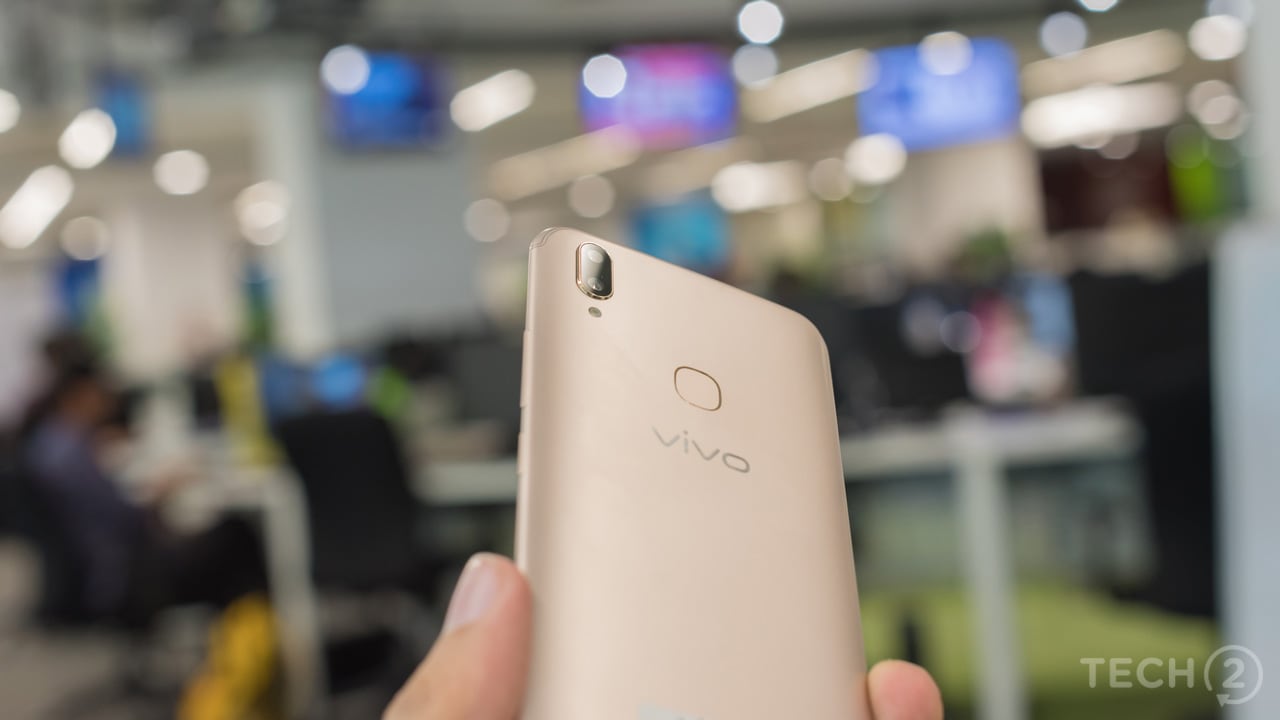 V9 was good with focusing, with no issues except in extremely low-lit
conditions. Vivo has added 'AR Stickers', which are not to be confused
with AR Emoji or Animoji like avatars. These are virtual accessories
like sunglasses and caps that you can add to your image.
V9 was good with focusing, with no issues except in extremely low-lit
conditions. Vivo has added 'AR Stickers', which are not to be confused
with AR Emoji or Animoji like avatars. These are virtual accessories
like sunglasses and caps that you can add to your image.
The ‘AR Stickers’ mode is available both for the front and the rear cameras.
Low light images from the Vivo V9 are not good as there is no detail, texture or accurate colour reproduction in the final images. Moving to the front camera, there is not much to say about it since it is the best front camera in the market, offering a good amount of detail. People interested in buying a selfie-centric smartphone will love the quality of images on this shot. The portrait mode, along with the front camera, does a decent job in detecting the face and then blurring the background. It is no Google Pixel 2, but does a good enough job.
When comparing the images with those from its rival, the Oppo F7, the V9 produced images with more true to life colours. Oppo turned the vibrancy of colours in its selfies to a higher level, giving an unnaturally 'vivid' look. The Oppo F7 edged the Vivo V9 marginally when it came to images from the back camera because of more vivid colours and better noise control. However, both the devices fell flat when it came to low-lit conditions. The F7 does take a comparative lead here with its better noise control.
Battery: 6/10
The battery compartment is a mixed bag for the Vivo V9 as it lasted about 9.5 hours with my daily usage. This is barely a full working day. The usage would include two email accounts on sync, constant emails, gaming for about an hour, WhatsApp and Telegram messages, 15-20 photos and listening to music for about an hour or so. The device lasted 8 hours on the PCMark Work 2.0 battery life test with the screen on constantly for the length of the test.
The V9 packs in a 3,260 mAh battery, which is an improvement over the 3,000 mAh in the Vivo V7. I was expecting the battery life to be a bit better because the device does not come with a 2K display or a flagship processor.
Verdict and Price in India: Rs 22,999
Vivo has some advantage over its competition as it has been successful in bringing the first Android-powered phone with a notch to India, a rather dubious distinction, but a distinction nonetheless. However, there is nothing special that this device offers apart from that display and that 24 MP front camera. In fact, the 24 MP camera has not really changed except for the added ability to record 4K, when compared to its predecessor the Vivo V7.
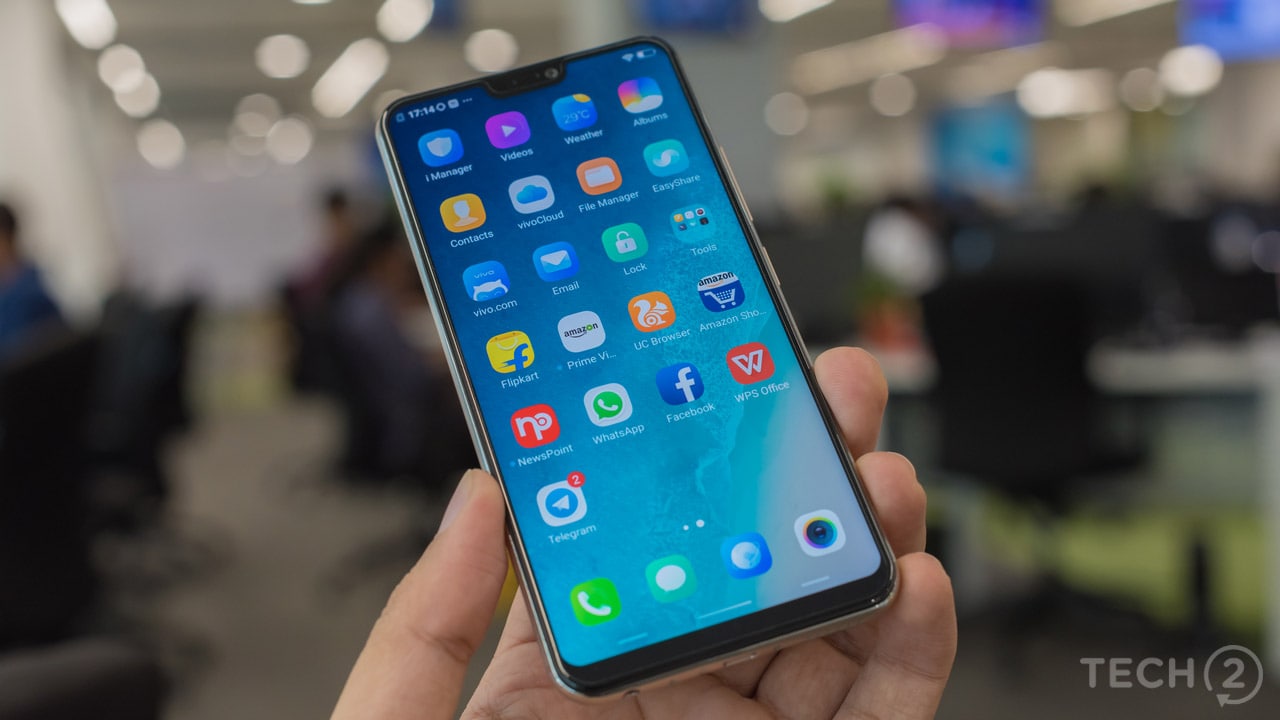 To recap, the device packs a decent back camera, slightly outdated
mid-range processor and a really good front camera. The notch and
edge-to-edge display and design is exciting enough now, but within
weeks, it'll be lost in a flood of notch-toting Android smartphones. In
that crowd, the V9 will not stand out.
To recap, the device packs a decent back camera, slightly outdated
mid-range processor and a really good front camera. The notch and
edge-to-edge display and design is exciting enough now, but within
weeks, it'll be lost in a flood of notch-toting Android smartphones. In
that crowd, the V9 will not stand out.
On the top of that, it is not really offering great value for money. Devices like the Rs 9,999 Redmi Note 5 easily outperform the V9 in several metrics, for example. Right now, the only novelty that the V9 offers is the fact that it's the cheapest copy of the iPhone X now available.
If you are looking for a much powerful device and don’t really require that great a front camera, then you can look at the Xiaomi Redmi Note 5 Pro or the Redmi Note 5. If you want a much more stylish offering then you can look at the Moto X4. However, if your priority is great selfies and you don't mind walking around with an iPhone X wannabe, you need look no further than the Vivo V9.

Vivo V9. Image: tech2/Rehan Hooda
The phone brings with it a relatively new design
with ‘near bezel-less display’ and almost edge-to-edge design. The V9
becomes the first Android-powered device in the Indian market with “the
notch”. Since the launch of V9, Oppo has also launched the Oppo F7, which
features an almost identical design. Huawei, ASUS, Xiaomi and just
about every Android phone maker in the world is clamouring to bring a
notch to the market (Apple sets trends, but they're not necessarily good
trends). The V9 is only the first one to arrive here, but it's not
going to be the last.
First-mover advantage notwithstanding, what else does the Vivo offer,
and will it stand out in a crowded market when all we'll see is the
notch?Build and Design: 7.5/10
The first thing that you notice when you first switch on the Vivo V9, or see someone using it, is that lovely display and it's almost ‘edge-to-edge' design. Yes, the design — both hardware and software — is a complete and total rip-off of the iPhone and iOS, but once you get past that, you realise that the phone still makes quite an impression in this segment right now. However, once the market is flooded with notches, I really doubt this phone's ability to stand out.

Image: tech2/Rehan Hooda

Image: tech2/Rehan Hooda

Image: tech2/Rehan Hooda
There are no hardware navigation buttons to reduce the size of the bottom chin and Vivo has opted for software navigation buttons instead. Vivo has also added an iPhone X-like gesture-based navigation system that reduces the navigation buttons to mere indicators, increasing the effective screen estate for the content.

Image: tech2/Rehan Hooda

Image: tech2/Rehan Hooda
Features: 7/10
Vivo V9 packs in a 6.3-inch screen with FHD+ resolution and a 90 percent screen-to-body ratio with an iPhone X-like notch on the top, something I'll talk more about in the display section.
The V9 packs in a Snapdragon 626 SoC with 4 GB RAM and 64 GB internal storage. Vivo will also give users an option to add a microSD card with up to 256 GB capacity for expandable storage with the help of a ‘triple card slot’. It comes with a 16 MP rear camera sensor with an f/2.0 aperture and a 5 MP camera sensor for sensing the depth. A 24 MP camera sensor is on the front of the device.

Image: tech2/Rehan Hooda
Display: 7/10
The Vivo V9 will pack in a 6.3-inch IPS LCD screen with a 19:9 aspect ratio and an FHD+ resolution of 2280 x 1080 pixels. With that notch, you get a 90 percent screen-to-body ratio. Love it or hate it, that Android smartphone makers are adopting the notch. The display looks quite nice in real life.

Image: tech2/Rehan Hooda

Image: tech2/Rehan Hooda

Image: tech2/Rehan Hooda
Software: 6.5/10
The V9 sports Vivo's Android 8.1 Oreo-based Funtouch OS 4.0 out of the box along with the March Android security patch. As noted in my first impressions, Vivo tries to take the 'imitation is the best form of flattery' approach when it comes to iOS by making Funtouch OS 4.0 as visually close to iOS as possible. Everything, the icons, the notification tray, settings menu, calendar apps and more are heavily inspired by iOS. The company almost copies the swipe-up-from-the-bottom gesture to invoke the quick action bar with controls such as the Wi-Fi, Bluetooth, Data network, Rotation lock, brightness and volume controls.

The company claims a lot of Artificial Intelligence (AI)-powered smarts in the system, most of which are difficult to realise in the day-to-day functioning of the device. However, the company claims to pack 'AI Bokeh' along with the dual camera setup to make use of the algorithm and machine learning to “achieve amazing bokeh shots” along with “AI Face Access” for face unlock. Another feature called “AI Attention Sensing” improves the user experience, according to Vivo, by monitoring when you're looking at the phone. In this case, message notifications, alarms and other notifications will be more muted.
Face unlock works fine in most situations, but there were some situations where the phone could not recognise my face and I had to use my password to unlock the V9.

Vivo has added a number of built-in apps in the OS.

You can use WhatsApp to chat without leaving the game.

Other features that Vivo has added in the V9.

Some of the apps on the V9 look strikingly similar to native iOS apps.

The folder structure and even the Vivo Cloud logo is similar to the iOS counterpart.

Apps like calculator may not look similar to the iOS calculator app but the theme is quite similar in terms of colours.
Performance: 7.5/10
Moving to the performance of the device, it performs without any major hiccups, slowdowns or crashes. The device did tend to slow down a bit while multitasking and while playing heavy games, but that is alright given that it is powered by Qualcomm Snapdragon 626, which is a high-end chip, but one targeted more towards efficiency. Despite not running a Qualcomm Snapdragon 845 or 835, it ran smoothly through my intensive day-to-day usage without breaking into much sweat.
I did not experience any freezing or stuttering except maybe once or twice while playing Modern Combat 5, and only during intensive 1-hour long gaming sessions. However, considering that it packs a Snapdragon 626, it lags behind its competition when it comes to raw performance and benchmarks. What is surprising is that devices such as the Redmi Note 5 at almost half the cost manage to beat the V9 in some benchmarks.
V9 ran heavy games like Gear.Club, Breakneck, Modern Combat 5 and Dead Trigger 2 without much problem. One thing I need to point out is that the device did not get too hot during intensive gaming sessions, and the little heat that was there was evenly distributed on the rear side instead of being concentrated in one spot. The device was also relatively quick to cool down despite having a plastic back. I did not face any problems while making internet or cellular calls with the device as the connectivity and voice clarity were spot on.
Camera: 7/10
Vivo claims that the highlight feature of the device is its 24 MP camera sensor on the front of the device with its f/2.0 aperture for improved selfies. Vivo made some bold claims about the camera capability of the device during the launch event, adding that the V9 packs in a new ‘AI Face Beauty’ feature along with 'AI HDR' and an 'Ultra HDR' mode. The company added that an algorithm looks at the lighting conditions, age, gender, skin tone and the texture of the user to figure out the optimal settings for a selfie.

Image: tech2/Rehan Hooda

As mentioned earlier, the rear features a 16 MP + 5 MP dual camera, with the 5 MP unit acting as a depth sensor. This is Vivo's first rear-mounted dual-camera. The images shot on the V9 are good in daylight, featuring ample details and decent colour reproduction. I could notice the algorithm sharpening the images a bit more than necessary, but I preferred the final shots as they make it seem like the camera is capturing more details. The low light performance of the phone still needs improvement as the device tends to be extremely aggressive with the noise reduction.

The camera software gives users the option to take an HDR, portrait or Live Photo using the front camera, while switching to the back camera adds various 'mode' options, allowing users to select from ‘Ultra HD’, ‘Doc’ for scanning documents, ‘Slo-Mo’, and ‘Time-Lapse’ modes.
Talking about the shooting modes, the software offers ‘AR Stickers’, ‘Videos’, ‘Take Photo’, ‘Face Beauty’, ‘Panorama’, and ‘Professional’ modes. The ‘Panorama’ mode changes to ‘Group Selfie’ while switching to the front camera’. Though I am not a fan of the 'Face Beauty' mode for the over processing that it does while trying to even erase your stubble from your face. One thing to note here is that the company gives the option to shoot 4K video using the front camera, something that its rival the Oppo F7 does not provide.

Image: tech2/Rehan Hooda
The ‘AR Stickers’ mode is available both for the front and the rear cameras.
Low light images from the Vivo V9 are not good as there is no detail, texture or accurate colour reproduction in the final images. Moving to the front camera, there is not much to say about it since it is the best front camera in the market, offering a good amount of detail. People interested in buying a selfie-centric smartphone will love the quality of images on this shot. The portrait mode, along with the front camera, does a decent job in detecting the face and then blurring the background. It is no Google Pixel 2, but does a good enough job.
When comparing the images with those from its rival, the Oppo F7, the V9 produced images with more true to life colours. Oppo turned the vibrancy of colours in its selfies to a higher level, giving an unnaturally 'vivid' look. The Oppo F7 edged the Vivo V9 marginally when it came to images from the back camera because of more vivid colours and better noise control. However, both the devices fell flat when it came to low-lit conditions. The F7 does take a comparative lead here with its better noise control.
Battery: 6/10
The battery compartment is a mixed bag for the Vivo V9 as it lasted about 9.5 hours with my daily usage. This is barely a full working day. The usage would include two email accounts on sync, constant emails, gaming for about an hour, WhatsApp and Telegram messages, 15-20 photos and listening to music for about an hour or so. The device lasted 8 hours on the PCMark Work 2.0 battery life test with the screen on constantly for the length of the test.
The V9 packs in a 3,260 mAh battery, which is an improvement over the 3,000 mAh in the Vivo V7. I was expecting the battery life to be a bit better because the device does not come with a 2K display or a flagship processor.
Verdict and Price in India: Rs 22,999
Vivo has some advantage over its competition as it has been successful in bringing the first Android-powered phone with a notch to India, a rather dubious distinction, but a distinction nonetheless. However, there is nothing special that this device offers apart from that display and that 24 MP front camera. In fact, the 24 MP camera has not really changed except for the added ability to record 4K, when compared to its predecessor the Vivo V7.

Image: tech2/Rehan Hooda
On the top of that, it is not really offering great value for money. Devices like the Rs 9,999 Redmi Note 5 easily outperform the V9 in several metrics, for example. Right now, the only novelty that the V9 offers is the fact that it's the cheapest copy of the iPhone X now available.
If you are looking for a much powerful device and don’t really require that great a front camera, then you can look at the Xiaomi Redmi Note 5 Pro or the Redmi Note 5. If you want a much more stylish offering then you can look at the Moto X4. However, if your priority is great selfies and you don't mind walking around with an iPhone X wannabe, you need look no further than the Vivo V9.
Also See
-
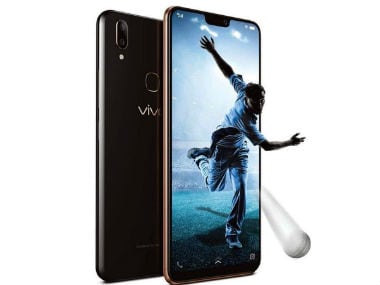 Vivo V9 Youth launched at Rs 18,990 in India; comes with a Snapdragon 450 SoC, 16 MP AI selfie-camera and more
Vivo V9 Youth launched at Rs 18,990 in India; comes with a Snapdragon 450 SoC, 16 MP AI selfie-camera and more
-
 Vivo quietly launches Y53i with 2 GB RAM, 16 GB storage and Snapdragon 425 SoC priced at Rs 7,990
Vivo quietly launches Y53i with 2 GB RAM, 16 GB storage and Snapdragon 425 SoC priced at Rs 7,990
-
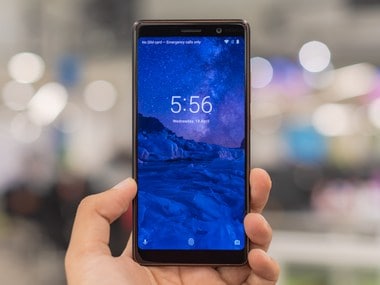 Nokia 7 Plus review: Perfectly balanced value for money phone with no competition in the Rs 25,000 segment
Nokia 7 Plus review: Perfectly balanced value for money phone with no competition in the Rs 25,000 segment
-
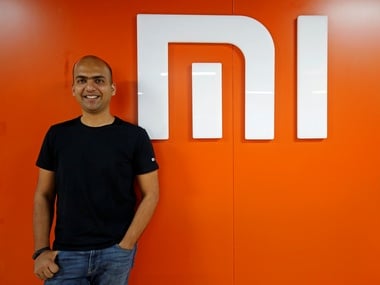 Xiaomi tops Indian smartphone market leading Samsung as Honor becomes fastest growing brand in Q1 2018
Xiaomi tops Indian smartphone market leading Samsung as Honor becomes fastest growing brand in Q1 2018












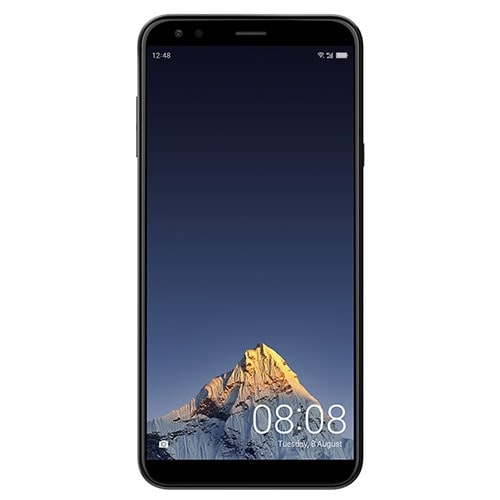
 Narendra Modi-Xi Jinping meet: Discussions don't mean much unless China aligns its actions with words
Narendra Modi-Xi Jinping meet: Discussions don't mean much unless China aligns its actions with words Karnataka polls: Congress manifesto a potpourri of time-tested freebies, copies jumlas that helped Modi win 2014
Karnataka polls: Congress manifesto a potpourri of time-tested freebies, copies jumlas that helped Modi win 2014 Avengers: Infinity War registers 2018's highest opening day figures in India, beating Padman, Padmaavat
Avengers: Infinity War registers 2018's highest opening day figures in India, beating Padman, Padmaavat North Korean media hails Kim Jong-un's meeting with Moon Jae-in, highlights themes of peace, prosperity and unity
North Korean media hails Kim Jong-un's meeting with Moon Jae-in, highlights themes of peace, prosperity and unity Premier League: Chelsea beat Swansea to keep Champions League hopes alive; Liverpool draw against Stoke City
Premier League: Chelsea beat Swansea to keep Champions League hopes alive; Liverpool draw against Stoke City
Commentaires
Enregistrer un commentaire